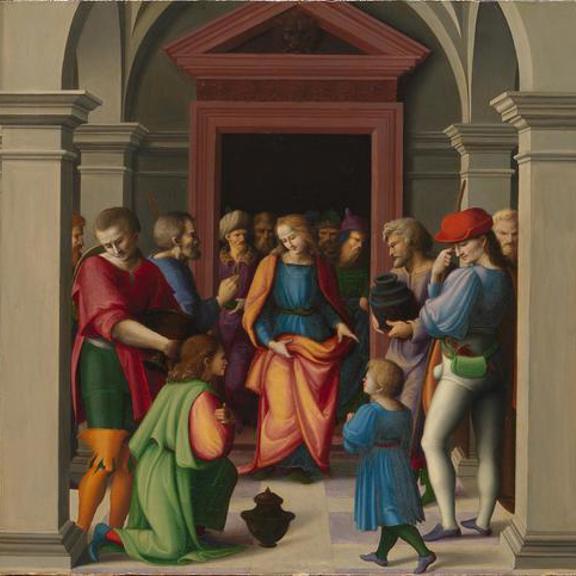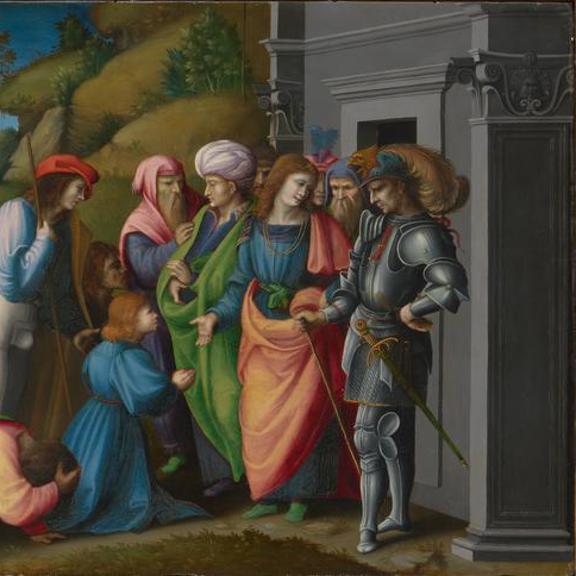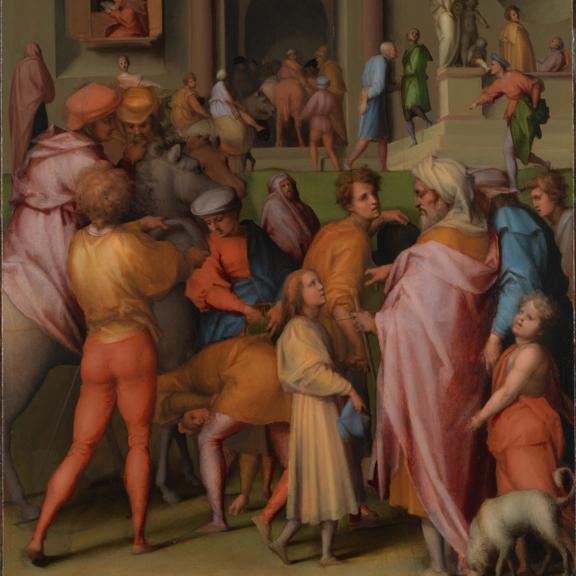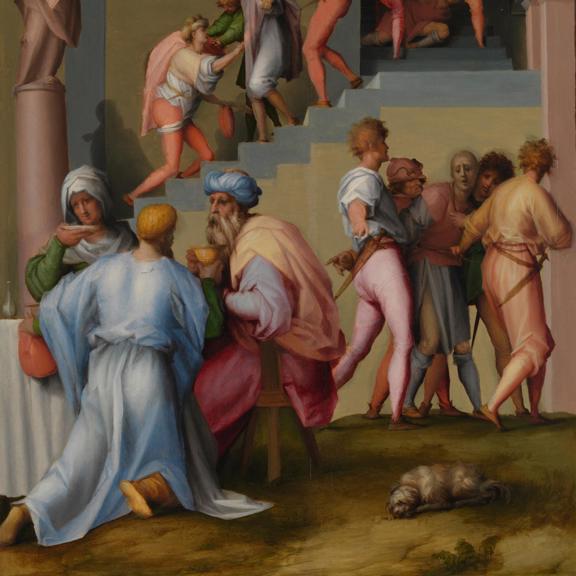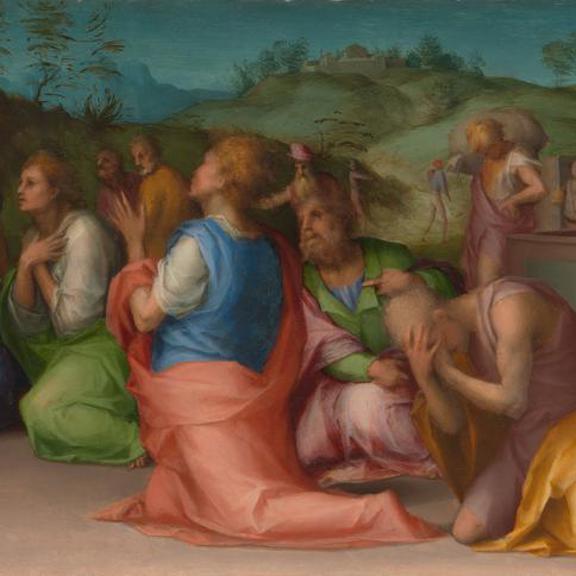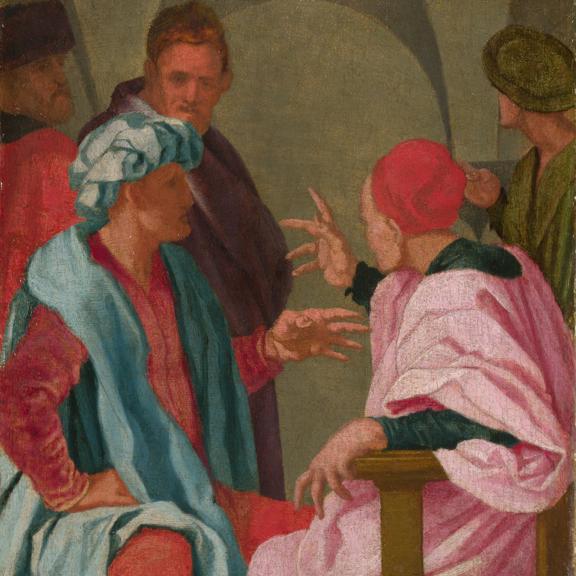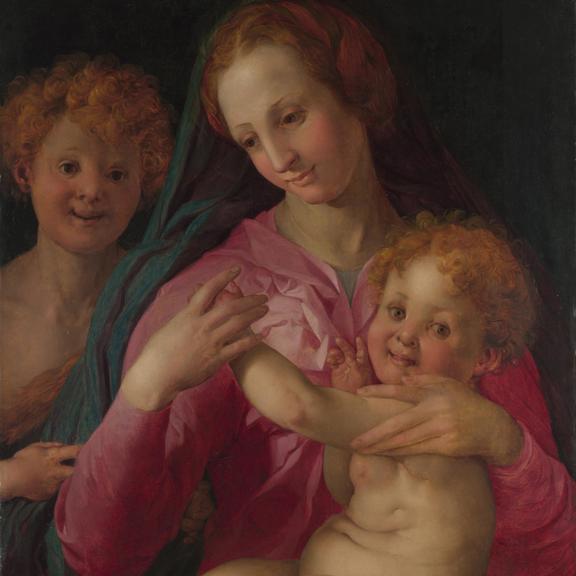Pontormo, Joseph's Brothers beg for Help
Scenes from the Story of Joseph
These six pictures by Pontormo and Bacchiacca were part of a larger series of panel paintings commissioned to celebrate the marriage of Pierfrancesco Borgherini to Margherita Accaiuoli in 1515. The series decorated the couple’s bedroom in the Borgherini palace in Florence. Francesco Granacci and Andrea del Sarto also contributed to the decorative scheme, which would have been one of the most sumptuous of the time. The paintings, telling the story of Joseph from the Old Testament (Genesis 39), would have been set into the wall panelling and furniture.
Pontormo’s interest in the emerging new style known as Mannerism – a reaction against the harmony, proportion and naturalism of High Renaissance art – is evident in his bright colours, disconcertingly unnatural approach to space, elongated figures and spiralling compositions. Bacchiacca’s scenes are expressive and dramatic but stylistically more conventional.
These six pictures by Pontormo and Bacchiacca were part of a larger series of panel paintings commissioned to celebrate Pierfrancesco Borgherini’s marriage to Margherita Accaiuoli in 1515. Granacci and Andrea del Sarto also contributed to the decorative scheme for the marital bedchamber in the Borgherini palace in Florence, which was commissioned by Borgherini’s father and would have been one of the most sumptuous of the time. Fourteen of the panels survive. The other panels are Granacci’s Joseph presents his Father and his Brothers to the Pharoah (Uffizi, Florence) and his tondo of the Holy Trinity (Gemäldegalerie, Berlin); Andrea del Sarto’s two Stories of Joseph (Galleria Palatina, Florence); Bacchiacca’s four Stories of Joseph (Galleria Borghese, Rome).
The pictures tell the story of Joseph from the Old Testament (Genesis 39). They were originally set into the sumptuous walnut wall panelling, the marriage bed, the chairs and storage chests. The story of Joseph was fashionable at the time for furniture decoration and – with Joseph’s coat of many colours, his ability to interpret dreams, the story’s emphasis on success, family and forgiveness – was a particularly appropriate subject for a bedchamber.
Joseph was his father’s favourite son and had been given a coat of many colours by him. His jealous half-brothers sold Joseph to a caravan of Ishmaelite merchants taking perfumes and spices to Egypt. The brothers smeared Joseph’s coat with goat blood and told their father that he was dead.
Joseph sold to Potiphar by Pontormo shows Joseph standing before his new master, Potiphar, the captain of the Egyptian Pharaoh’s guard. Joseph became overseer of Potiphar’s household. However, after he refused the sexual advances of Potiphar’s wife and she falsely accused him of rape, he was thrown into jail. There Joseph interpreted the dreams of Pharaoh’s butler and baker. As Joseph predicted, Pharaoh spared the butler but had the baker killed.
Two years later, Pharoah had a mysterious dream that none of his advisers could understand. Joseph explained that Pharaoh’s dream of seven fat cows followed by seven thin cows meant that seven years of plenty would be followed by seven years of famine, and he advised Pharaoh to stockpile grain. Pharaoh made Joseph his vizier, the second most powerful man in Egypt.
Having travelled from Canaan to Egypt in the second year of the famine, Joseph’s brothers beg for help, but they do not recognise their long-lost brother. Joseph accuses his half-brothers of spying and demands that they bring their younger brother to Egypt to prove their honesty. In Joseph receives his Brothers on their Second Visit to Egypt by Bacchiacca the brothers return to Egypt with their youngest brother, Benjamin. Joseph sends the brothers home but hides a cup in Benjamin’s sack. In Joseph pardons his Brothers, also by Bacchiacca, the brothers are brought back to Joseph, with Benjamin a prisoner. Joseph threatens to enslave Benjamin, but when his brother Judah offers to take Benjamin’s place, Joseph reveals his true identity. He forgives his brothers for selling him into slavery. In the last painting of the series, Joseph with Jacob in Egypt, the stories of Joseph and his father are combined as four scenes in a continuous narrative. The story ends with the elderly Jacob on his deathbed blessing Joseph’s sons.
The story of Jacob and Joseph, and the enduring love between them, was an appropriate one for a father to commission for the decoration of his own son’s bedchamber.


